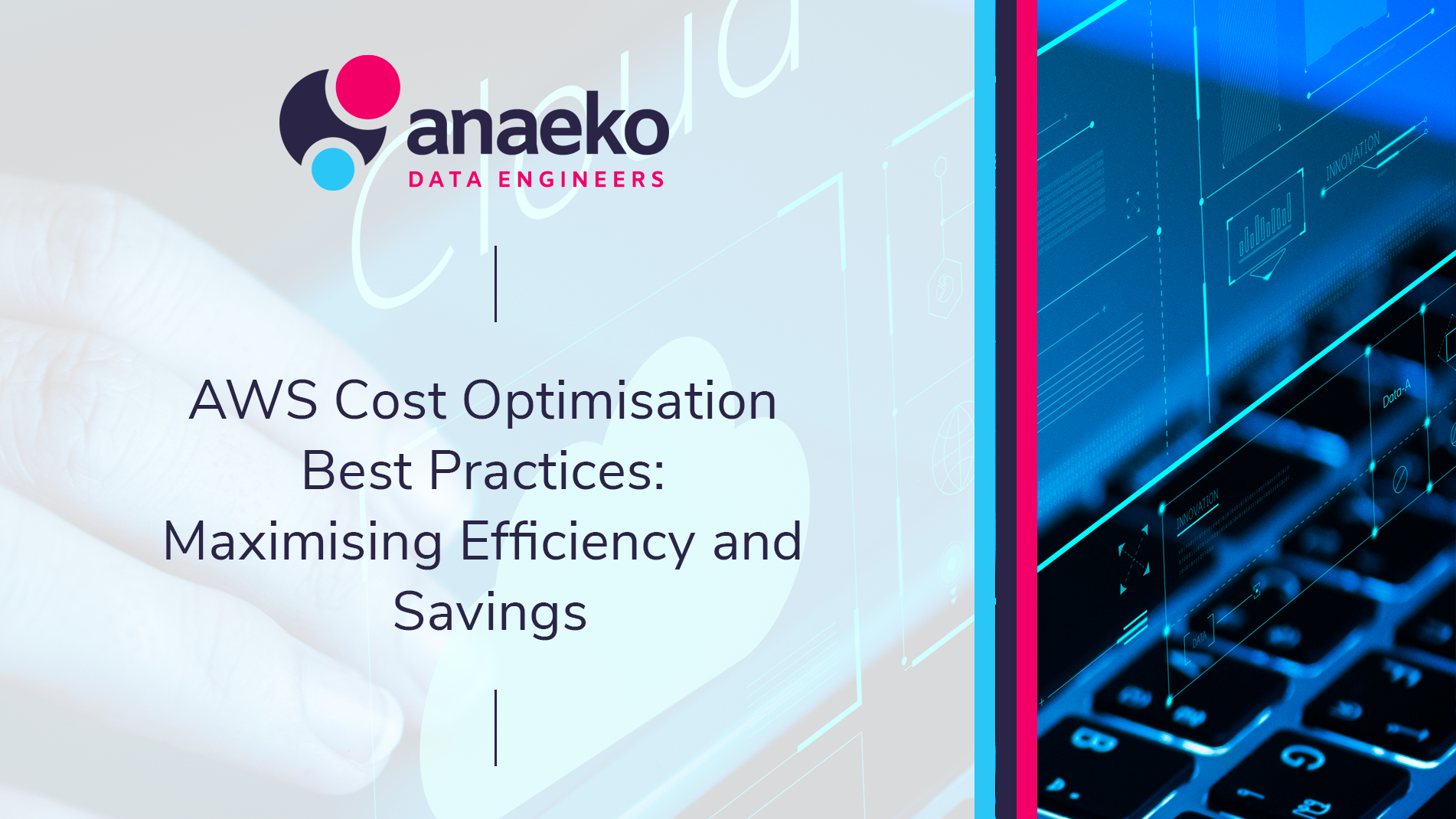Cost optimisation is a top priority for organisations leveraging AWS (Amazon Web Services) to drive their cloud initiatives. To help businesses achieve maximum cost efficiency, Anaeko offers a comprehensive AWS Well-Architected Review that focuses on identifying cost-saving opportunities in your AWS infrastructure. We will explore the best practices for cost optimisation in AWS and how an AWS Well-Architected Review conducted by Anaeko can help you identify potential areas for savings, optimise resource utilisation, and drive down your cloud costs. Good cloud governance always starts with a Well-Architected Framework and an architecture precisely designed to meet workload requirements. AWS offers a rich array of options in order to streamline your operations, and continuously optimise your deployment. We will look at the best practices to monitor the financial impact of decisions and optimise for cost.
The Importance of Cost Optimisation in AWS
Sizeable parts of IT budgets are now on cloud service providers with most applications and services now hosted on cloud, bills and budgets for this hosting is becoming a prime concern. Cost optimisation can free resources, scaling applications cost-effectively, and having these resources, to in-turn, finance more projects and better serve customer needs. Having review and cost optimisation plans allows for long-term improved financial stability with the right AWS Architecture in place to scale while also minimising expenditure.
Understanding AWS Cost Optimisation Best Practices
The AWS Well-Architected Framework recommends 5 design principles to follow for cost optimisation:
Implement cloud financial management: To achieve financial success and accelerate business value realisation in the cloud, you must invest in Cloud Financial Management. Your organisation must dedicate the necessary time and resources for building capability in this new domain of technology and usage management. Similar to your Security or Operations capability, you need to build capability through knowledge building, programs, resources, and processes to help you become a cost efficient organisation.
Adopt a consumption model: Pay only for the computing resources you consume, and increase or decrease usage depending on business requirements. For example, development and test environments are typically only used for eight hours a day during the work week. You can stop these resources when they’re not in use for a potential cost savings of 75% (40 hours versus 168 hours).
Measure overall efficiency: Measure the business output of the workload and the costs associated with delivery. Use this data to understand the gains you make from increasing output, increasing functionality, and reducing cost.
Stop spending money on undifferentiated heavy lifting: AWS does the heavy lifting of data centre operations like racking, stacking, and powering servers. It also removes the operational burden of managing operating systems and applications with managed services. This allows you to focus on your customers and business projects rather than on IT infrastructure.
Analyse and attribute expenditure: The cloud makes it easier to accurately identify the cost and usage of workloads, which then allows transparent attribution of IT costs to revenue streams and individual workload owners. This helps measure return on investment (ROI) and gives workload owners an opportunity to optimise their resources and reduce costs.
5 Strategies for AWS Cost Optimisation
1. Data Driven Instance Optimisation
Choosing the right instance is only the first step toward cost optimisation. The cloud is a very dynamic environment. AWS is expanding choices for instance type regularly, and your business needs are constantly evolving. Making a data-driven choice is a great start, but it is just as important to stay on your feet and constantly evaluate choices available for optimisation.
Continuous re-evaluation of your instance choices will help ensure that you’re always staying ahead of the pricing changes in AWS, as well as your business requirements. Change comes at a cost and with its own risks; you should have a mechanism in place to perform a cost-benefit evaluation before making a change. Continuous instance optimisation will help you stay ahead of the pricing curve and leverage cost-optimisation without investing in any structural or architectural changes to your applications.
2. Serverless Computing
AWS Serverless Computing (Lambda) provides a DevOps-friendly, provision-free, highly scalable, and highly available environment automatically, without having to build the supporting infrastructure in EC2. AWS Lambda is increasingly becoming a deployment architecture of choice for applications and data processing workflows.
Lambda pricing is multi-dimensional and based on number of transactions, memory allocated to the function, and runtime, each of which can change many times according to business requirements.
If you have a function that is not invoked often, Lambda will almost always be cheaper than EC2. If you have a function that is invoked often but is not resource-intensive, then it will most likely be cheaper to run this in Lambda. If you have a resource-intensive function that runs very frequently, then it is possible that an EC2-based architecture may be the right choice. Alternatively, it could be that the function has been over provisioned with memory; perhaps the function could be optimised in terms of runtime or memory utilisation.
Optimising Lambda costs is about adjusting the lever between memory allocation and execution time to find the optimal balance. AWS Lambda Power Tuning helps optimise the performance and cost-effectiveness of AWS Lambda functions by using machine learning to analyse and optimise a Lambda function’s configuration parameters, such as memory allocation, timeout settings, and concurrency levels.
The ability to analyse and optimise Lambda costs will not only result in a more DevOps friendly and scalable architecture, it will also lower your operational costs by reducing the number of different types of resources that need to be managed.
3. Pro-active Cost Management
Cost-management is a challenge for all public cloud users; it is not uncommon for cloud spend to grow significantly past initial projections and still be overlooked until it is too late. AWS provides numerous mechanisms to manage costs, but unfortunately, many of them are disabled by default and should be enabled as a best practice. By proactively managing costs, you can start to define and enforce good cloud cost governance. This will increase the accuracy of your short-term spend forecasts and proactively manage any spending spikes in real time.
4. Leverage Reservations
Reservations are the easiest way to optimise your AWS costs because using them requires making no technology changes. Reserved Capacity is available for various services; EC2 Reserved Instances are the most popular, due to the relative size of EC2 spend over other services.
Managing your reservations is just as important as purchasing them; unused reservations are one of the easiest ways to lose money in AWS. Look at your EC2 estate, and find opportunities for saving via reservations. There are typically plenty of low-hanging fruit; long-running instances that haven’t changed in a long time. Pick from your historic cloud instance usage patterns and real time price vs. performance.
Reservations allow you to get pricing breaks on AWS instances without making any changes to your deployment. Intelligently purchasing Reserved Instances is important, but managing Reserved Instances and ensuring that they are being applied towards utilisation will have an even bigger impact on AWS costs.
5. Organisation wide shared responsibility
AWS operates on a shared responsibility model, which is an excellent template for building a shared security model across the organisation. By giving end-users the tools they need to monitor their own security and remediate issues, you convert security from a centralised function to one that is distributed across the organisation. AWS has a built-in tool called Trusted Advisor, which can check the status of your resources against AWS Best Practices and can manually remediate, reduce costs, and monitor service quotas.
Conducting a Well-Architected Review for Cost Optimisation
Cost optimisation in AWS is a critical component of a successful cloud strategy. By adopting best practices, leveraging a Well-Architected Review, and implementing the recommended cost optimisation strategies, businesses can drive down their cloud costs, increase operational efficiency, and maximise their return on investment. Partner with Anaeko to conduct a comprehensive Free AWS Well-Architected Review and unlock the potential for cost optimisation in your AWS infrastructure. Contact us today to embark on a journey towards a more cost-efficient and optimised cloud environment. It is important to review your AWS Architecture all the time to reach an optimum cost of the infrastructure. It is not a one-time activity.
Topics: Cloud, Cloud services, public cloud, Amazon AWS, AWS Partner, AWS, AWS Cost Optimisation, Cloud Costs





